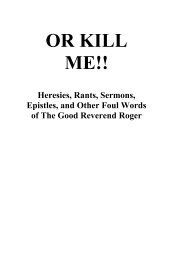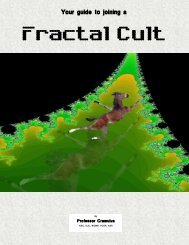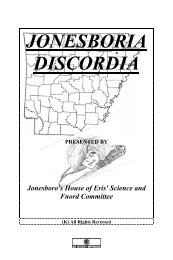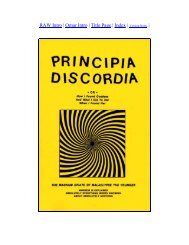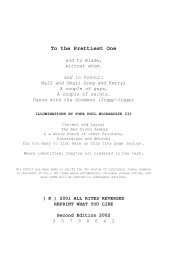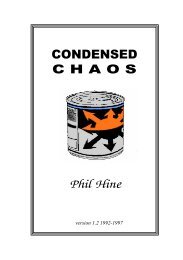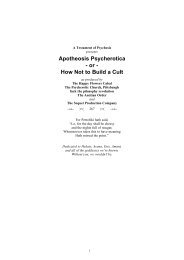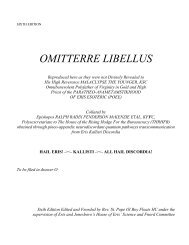Coincidance - Principia Discordia
Coincidance - Principia Discordia
Coincidance - Principia Discordia
You also want an ePaper? Increase the reach of your titles
YUMPU automatically turns print PDFs into web optimized ePapers that Google loves.
154 COINCIDANCE<br />
and telekinesis, there might just be one ACOP—acausal coincidental<br />
principle—appearing to us in many forms to which we give those names.<br />
Another angle on the problem comes from Dr. David Bohm's hiddenvariable<br />
theory, developed from some ideas of Einstein's. According to<br />
Bohm, below the quantum level there is a subquantum world of hidden<br />
variables. This is a metaphor. Bohm does not mean below in the ordinary<br />
sense but, in a logical sense, what Bohm means is that the space-time world<br />
observed in physics is an epiphenomenon, a phenomenon caused by<br />
another phenomenon; underlying it is a spaceless, timeless realm from<br />
which the events of ordinary reality emerge. Bohm uses this theory to<br />
explain, or transcend, the notorious indeterminacy of the quantum realm<br />
(where ordinary causality breaks down), but it could also explain the acausal<br />
coincidences we are discussing.<br />
Whether we take Bell's interpretation of quantum mechanics or Bohm's,<br />
we seem to arrive at a world in wich all things are very intimately connected,<br />
no matter how far apart and seemingly unconnected they may appear in<br />
ordinary space and ordinary time. This may sound like Buddhism or other<br />
mystic teachings, but other quantum theorists have come to similar<br />
conclusions by other avenues. Nobel laureate Erwin Schrodinger decided, as<br />
early as 1945, that the only sane explanation of quantum wave mechanics<br />
was that "The mind... is something we simply cannot conceive of as plural."<br />
Barbara Honegger has a model that united all these approaches with<br />
current neurology. The brain, in a general, way has two hemispheres. The<br />
left hemisphere seemingly does all the talking (except in dreams and<br />
schizophrenia); it is the seat of the conscious ego. The right hemisphere is<br />
often called the silent hemisphere because it talks much less. It is also very<br />
active in hypoexcitation (deep yogic trance), in hyperexcitation (LSD trips,<br />
wild dancing, etc.) and while listening to music.<br />
Honegger believes that the right hemisphere ego consciousness is<br />
continually trying to assert its existence and communicate with the left<br />
hemisphere ego, which Western adults think is their only ego. The rightside<br />
ego usually communicates via dreams, as noted by Freud and Jung, but<br />
if the left-sided ego remains deaf to these messages, the right hemisphere<br />
creates Freudian slips or hysterical symptoms to get the ego's attention.<br />
And, if nothing else works, it produces an ACOP. It does this, Honegger<br />
suggests, by means of connecting principles such as those suggested by Bell<br />
and Bohm. According to Honegger, we should analyze such ACOPs the<br />
way Freud and Jung analyzed dreams to see what unconscious messages<br />
they contain.



